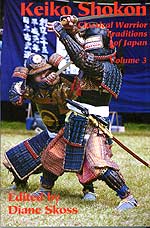Book Review
Keiko Shokon:
Classical Warrior Traditions of Japan, Volume 3
Edited by Diane Skoss

Review by Ken Mondschein
Judo, karate, kendo, aikido—most of the Japanese martial arts,
as practiced today, are relatively recent inventions, taking shape in
the era of Japanese nationalism, military build-up, and expansion following
the Meiji Restoration. Their forms reflect their times: They are characterized
by regimented group practice, a focus on building spirit, an emphasis
on competition, and strict systems of ranking. Contrast this with the
koryu bujutsu, which are, broadly defined, the martial arts of pre-Meiji
Restoration-era Japan. Rather than the hierarchies of the “gendai
budo,” including governing bodies, the koryu are passed down in
ryu, semi-feudal “family” traditions, and their pedagogical
method is completely different. The late, great Donn Draeger was the first
Westerner to bring widespread attention to the koryu bujutsu. Yet, Draeger’s
writings presented only one point of view of a complex subject, and left
many misconceptions, such as the oft cited “-do” versus “-jutsu”
controversy.
Diane Skoss, like Draeger, is a writer who spent many years living in
Japan, drinking from the wellspring of these rare arts. Unlike Draeger,
her books combine a multiplicity of voices, being composed of essays written
by eminent authorities on the classical Japanese martial arts. The first
book in Skoss’ series, “Classical Warrior Traditions of Japan,”
sought to define what the koryu bujutsu are. The second tried to approach
the essence of these arts. Her third book, however, is concerned not with
the past or present, but with the future. What lies ahead for the koryu
bujutsu in a world grown increasingly impersonal and mechanized, where
“martial arts,” to many Japanese, means high-school Phys Ed.
kendo, and in which many of those most interested in learning these arts
are, in fact, non-Japanese? Can the koryu be successfully transplanted
to foreign soil? Does their spirit change?
Essays in this book include a Japanese parable on the nature of skill
in the fighting arts, translated by Karl F. Friday; an essay by Dave Lowry
on the dangers of attempting to study more than one koryu (which should
be required reading for anyone purporting to follow a regimen of “cross-training”);
Liam Keeley’s interview with Nitta Suzuyo, the headmaster of the
Toda-ha naginata ryu; Ron Beaubien’s insightful observation on the
difficulty of trying to leanr about the koryu by mere observation; an
overview of the methods and practice of Itto-ryu kenjutsu; a discourse
by William M. Bodiford on what exactly the often-misused term “soke”
actually means; Ellis Amdur’s essay on the perils of trying to improve
on centuries-old traditions; and, finally, United States Marine Corps
Lieutenant Colonel George H. Bristol’s observations on the koryu
as fighting arts and combat training.
“Keiko Shokon,” as well as the first two books in the series,
is well worth reading by anyone interested in the history behind our modern
practice of Japanese martial arts. For those who wish to practice the
koryu bujutsu themselves, they are an invaluable resource. Finally, the
philosophical questions they raise on such issues as change and tradition
are
well worth considering in and of themselves. This book is highly recommended.
This book is available from the FightingArts Estore:
Published by Koryu Books
(Paperback, 208 p., with 22 illustrations, bibliographical
references, and complete glossary/index.)
FAS 2030
US$21.95
(+$5 shipping within US)

3 Volume set:
Koryu Bujutsu: Classical Warrior Traditions Of Japan
Sword & Spirit: Classical Warrior Traditions Of Japan, Volume 2
Keiko Shokon: Classical Warrior Traditions of Japan, Volume 3
FAS 2040
US $55.95
(+$8 shipping within US)

About The Reviewer:
Ken Mondschein, is a New York City writer and amateur historian. After
achieving a masters degree in European History he became a student of
classical fencing and historical swordsmanship under Maestro Ramon Martinez.
He is also knowledgeable about European classical dressage, the art of
horsemanship, and its history and application in mounted combat. Other
martial arts studies include karate where he is now a student at the World
Seido Karate Organization's New York City headquarters. Mondschein currently
works in textbook publishing and is Associate Editor for European Sword
Arts for FightingArts.com. |